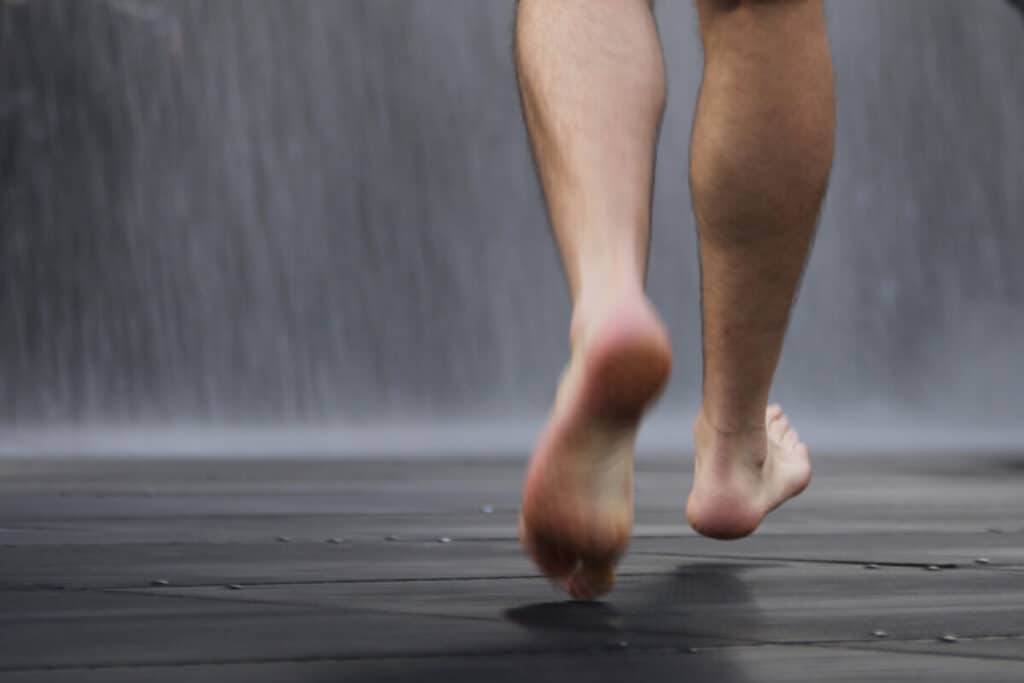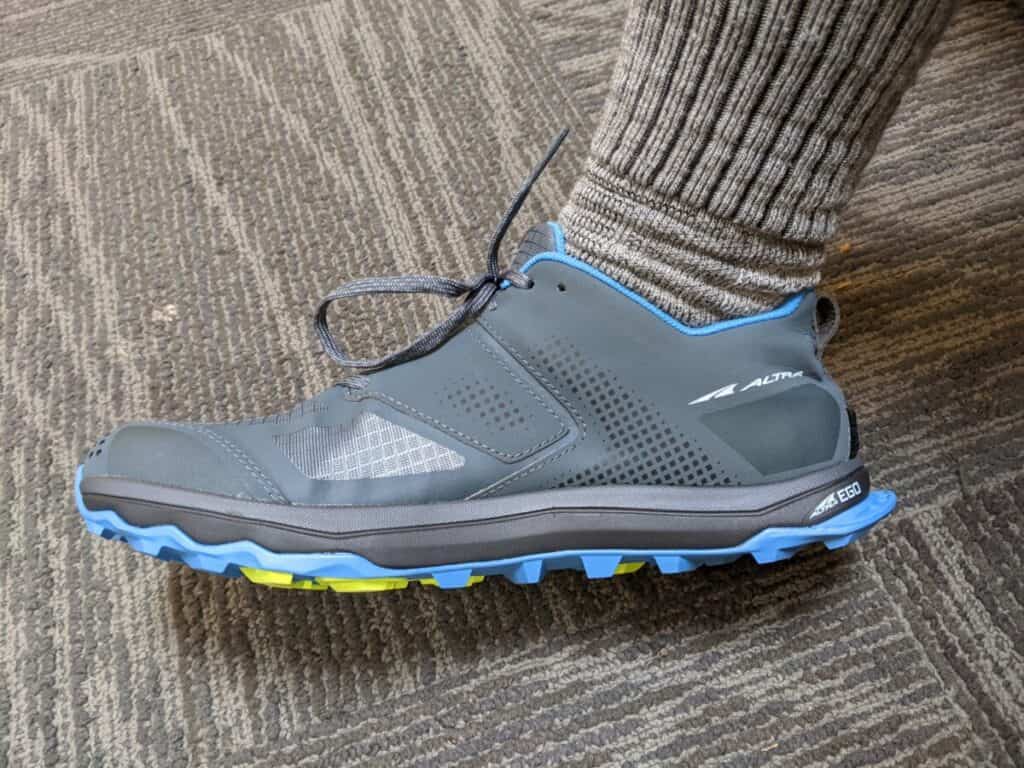People who run barefoot and with minimal shoes run differently when compared to the average runner with shoes. Adapting to a much lighter and gentler running form when running barefoot is something that happens naturally. Many people running in running shoes tend to strike with their heel first and, being protected by the shoe, are not aware of this. Running barefoot will change your running style and for some, can even improve your running speed.

(This article is written from a pro-barefoot running perspective. It is a controversial topic, and you should always experiment what works for you and consult professionals to help you find a running/hiking style that works for your body)
Running without shoes has the following effect on runners:
By the way, as an Amazon Associate, I earn when buying qualified products through links on my site.
- Automatically transition your running form from heel striking to toe-heel-toe.
- Lowers your impact transient.
- Reduces your effective mass at collision time.
- Increases foot strength and overall body strength.
- Increases speed
Sometimes society at large can be very judgmental. When runners see other runners running barefoot, the judgment usually is instantaneous. Comments like “there goes one of those fad runners” and “shame they probably can’t afford a good running shoe” are the norm. However, the barefoot runners will always incorporate a more natural, less stressful, running style than the average person running with shoes. ?
Why Do You Run Faster Without Shoes?
Running with supportive shoes has fundamentally changed how some of us run. The added support and overall comfort of today’s running shoes have spoiled us or instead allowed us, to start running differently. As long as these shoes are on our feet, we aren’t going to change our running form. It’s only when we return to running barefoot that we become aware of how unnaturally we run.
Automatically Transition Your Running Form From Heel Striking To Toe-To-Heel
Many runners with shoes tend to strike with their heel, and a running shoe with all the modern enhancements allows for these types of foot strikers to run this way. This striking with the heel, paired with a straight knee action and a stiff ankle slamming into the ground, creates a sudden collision called heel strike transient.
The generation of this transient creates a vertical shockwave that ultimately channels through your whole body up to your head. The human body has not evolved a strategy for dealing with this transient, hence the need for protective shoes. However, most shoe manufacturers have failed to consider that their cushioned elevated heel makes people run this way in the first place!
When running barefoot, you will automatically switch to a more natural running style, striking with your forefoot or midfoot. Employing a heel strike method of running will be uncomfortable and painful, hence the need to running gently and more comfortably in a more natural toe-to-heel fashion. Because your body is not coming to a constant stop, as what happens when striking with your heel first, it’s definitely possible to run faster barefoot. Landing on your middle-front foot position prepares your foot for immediate propulsion as your center of gravity moves forward of your foot.
Lowers Your Impact Transient
Impact transient means how much force our body feels when we hit the ground.
According to Dr. Daniel Lieberman, professor of Human Evolutionary Biology at Harvard University (source), people who run barefoot have a surprisingly different running strike when compared to runners with shoes. Barefoot runners run with a gentler style, hitting the ground very softly and with almost immeasurable impact transient. Simply put, our bodies go easy on our feet while barefoot running, whereas running with a heel strike we are less careful and we run with more impact.
Heel strike running creates an impact transient of 2-3 times your body weight (source at Harvard.edu). For example, if you weigh 120 pounds, then the impact force could be as high as 360 pounds per landing. With about 2600 landings per mile, that’s a lot of force! People running barefoot will not experience this impact on their bodies and will be able to run much quicker.
Reduces Your Effective Mass At Collision Point
The term “effective mass” refers to the amount of your body that comes to a dead stop when running as a percentage when at the collision point (heel or midfoot/forefoot hitting the ground).
- Heel strikers: Effective mass of 6-8% of the body-Foot and lower leg.
- Forefoot/midfoot strikers: Effective mass of 1.5% – Only the foot.
When you decrease the body parts that come to a dead stop at the collision point, you increase your running speed considerably. Your body will have to move again straight after contact, and that will require extra energy to do that. The less effective mass at the point of contact, the faster you will transition into your next step, meaning that you could be faster overall.
Heel Striking vs. Mid-foot striking
Dr. Lieberman’s findings are controversial, but there is a lot of evidence to support that barefoot style running (mid-foot strike) coincides with faster running speed.
Kenyans are some of the fastest runners on earth. Kenyans typically dominate long-distance running.
From my own research, I’ve seen some sources say that Kenyans train barefoot and others that say they train in regular running shoes. Indeed, some tribes are barefoot as a part of normal life.
From a different study from George Washington University (source), they found that most studied barefoot runners actually struck the ground with their heel at slower speeds (around 5MPH) while at higher speeds they transitioned to mid-foot strike.
Whether you should or should not use a mid-foot strike at slow speeds vs. fast speeds isn’t clear. But from research, I’ve learend that people’s bodies guide the running style. Wearing big blocky shoes locks you into a particular running/hiking style.
Transitioning to Barefoot Running
A helpful hint from Dr. Lieberman when switching to walking and running barefoot is to ease into it gradually. He mentions that by studying people who have worn shoes for most of their lives, their foot muscles and calf muscles were feeble. This is due to the added support of the shoes not allowing for natural muscle enhancement which occurs when running or walking barefoot.
By gradually starting to walk and run barefoot, you will strengthen every foot muscle and tone your leg muscles, as you, and not a shoe, will have to support and balance your weight. Training barefoot will enhance your speed in the long run as you gain muscle strength.
Overall Body Strength
One theory is that switching over to barefoot running will have a positive effect on the rest of your body as well. Not being supported by your shoes could directly lead to you toning your core (stomach and back muscles), as your feet will have to support your whole body weight without any aid. Your legs will be toned in a way that running with shoes doesn’t create. Some report improved balance as well.
Running barefoot will reboot your vestibular system (the system that helps you balance). The nervous system between your feet and the brain is much more active without shoes. This can help with your overall balance.
The stronger your feet and core become, the better your posture will become. You tend to walk taller and lighter when barefoot, which elongates your body and straightens your spine.
Increase Your Speed
Now for the critical part.
Transitioning to barefoot running is a process. Your body has likely adapted to its current support for potentially decades! Buying the first pair of barefoot shoes you put on and running 10 miles is the last thing you want to do.
The barefoot running theory is that you increase in speed as you adapt to your new running style, lose your impact transient, reduce your effective mass, and strengthen your feet and body. We were born to run barefoot, and this is how we evolved naturally over the years. A running shoe could change these natural and efficient running mechanics without you paying much attention to it.
This transition will take time, but you will get faster as your feet get back into the shape that they were when you were a child running barefoot all over the place, probably at a fast speed. To quote Dr. Lieberman, “how one runs probably is more important than what is on one’s feet, but what is on one’s feet may affect how one runs’’.
Should I Transition To Barefoot Running?
Switching from running with shoes to barefoot running should only be considered if you have no foot-related problems. If you suffer from sensory loss to the foot, you should probably continue wearing your running shoes.
This is a phenomenal blog post from a podiatrist on the matter. The key takeaway for me is that you shouldn’t rush to barefoot running as the answer to all of your foot problems, but it is to be carefully evaluated if you are an experienced runner. If you have little running experience and conditioning, starting out with barefoot running can lead to serious injuries.
Making the transition could be difficult and painful in the beginning as you start to undo the unintentional conditioning done over the years by wearing shoes all the time. Start practicing at a slow and gentle pace, as your feet will hate you if you run a 5k barefoot.
Here’s the rub. Many people have tried barefoot or “barefoot” shoes while running or hiking and they have had terrible consequences. It’s not enough to say that it’s because they “did it wrong.” It really is okay if you try it for a while, and if you have issues, to not go further.
Everybody’s musculoskeletal structure is different–everyone has a different body/fat percentage–there really is no such thing as one size fits all.
So, it’s really up to you to determine what works for you. Be careful! Resist the temptation to go on a big hike with no barefoot shoes or no shoes at all without careful prep and training.
Barefoot Shoes
“Going barefoot” often means to wear shoes, ironically. The difference with new barefoot shoes these days is they have “zero drop”. Which is a phrase that means that the heel is not raised so it is as if you were walking or running barefoot.

Altra’s Lone Peak shoes (men and women) are a popular shoe today that have “zero drop”. If you are planning on going truly barefoot, then a shoe like this with zero or a little drop might help you make that transition.
If you search for barefoot shoes at REI you’ll get results like these.
Can You Run Faster With Shoes?
Whether you wear shoes or whether you run barefoot has little to do with your top speed although shoes can increase traction which can theoretically increase speed in some situations. The real difference between running barefoot or with shoes is how long your body can run, not how fast.
If your body is adapted to shoes, you will be able to run for much longer than you can barefoot.
Conclusion
Running barefoot with little to no support is how humans have run for thousands of years. As soon as your feet become used to running barefoot and without the support of a shoe, you will be able to run on hard surfaces without any pain or discomfort— strengthening your feet and body in the process.
A softer, natural running style (forefoot to midfoot striking), with less impact transient and effective mass, will put less pressure on your body and can potentially allow you to run faster.
Other reading:
Is it better to run without shoes? | Science Illustrated
10 Reasons to Go Barefoot | runbare.com
Barefoot Running – does it make you faster or prevent injuries? (betterrunner.com)
